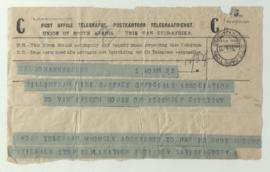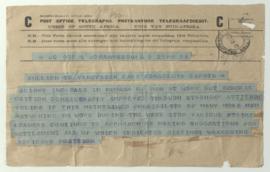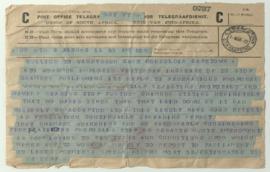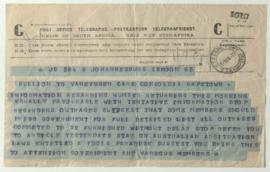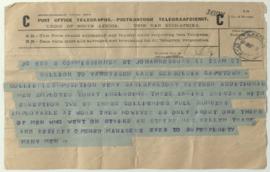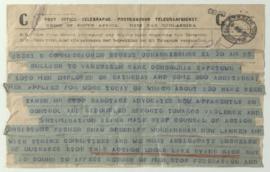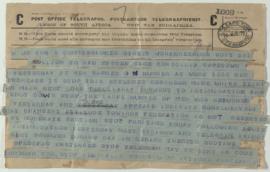Zone d'identification
Cote
Titre
Date(s)
- 1922 (Production)
Niveau de description
collection
Étendue matérielle et support
Form of materialCables
Zone du contexte
Nom du producteur
Notice biographique
Dr. J.L. Van Eyssen was a Mining Engineer at Care Consoldia, Cape Town.
Histoire archivistique
Source immédiate d'acquisition ou de transfert
Zone du contenu et de la structure
Portée et contenu
Cables dated 22 February to 20 April 1922 (2 unrelated later cables included).
The cables, sent between 22 February and 20 April 1922, are addressed to Van Eyssen, Care Consoldia, Cape Town, being Dr. J.L. Van Eyssen, who was a Mining Engineer. During the Rand Rebellion of 1922 he was involved in the negotiations between Parliament in Cape Town, the Chamber of Mines, and authorities in Johannesburg. Some cables are written in coded language.
The cables in their chronological order demonstrate, how events unfolded from wage demands, developing into intimidation and violence and open rebellion. In February negotiations broke down between the Chamber of Mines and the South African Industrial Federation, which the cables claimed were involved in the strike. The cables also demonstrate how white mob violence lead to a random and widespread killing of black miners. Later, on the 11 March the cables reveal the readiness by the Chamber of Mines to meet with representatives of Mining Unions, but not of the Federation, at the same time informing how Government troops advanced against strikers from the 15 March on, taking strikers prisoners. The strike ceased to be effective as from Thursday 16 March. The cables indicate attempts by the Federation to re-establish itself, and how workers were now quick to seek re-employment, and the Mining houses being cautious whom they employ.
The first line of text is used as a description. Some of the cables appear to be written in code.
Évaluation, élimination et calendrier de conservation
Accroissements
Mode de classement
Zone des conditions d'accès et d'utilisation
Conditions d’accès
Conditions de reproduction
Langue des documents
Écriture des documents
Notes de langue et graphie
Caractéristiques matérielle et contraintes techniques
Instruments de recherche
Instrument de recherche
Zone des sources complémentaires
Existence et lieu de conservation des originaux
Existence et lieu de conservation des copies
Unités de description associées
Zone des notes
Note
Biographical and administrative history: The Rand Rebellion of 1922, also referred to as the Rand Revolt or Red Revolt, occurred after a period of ongoing industrial unrest, when mining companies were faced with rising costs and a fall in the price of gold, leading to a sharp increase in the employment of cheap black labour at the expense of protected and higher paid white labour. The year 1922 started with strikes on the collieries of the Transvaal, spreading to the gold mines of the Reef, and eventually turned into an open revolution in a bid to capture the city of Johannesburg. The rebellion was crushed, costing 200 lives, more than 1000 people injured and millions of pounds in losses. Some of the leaders of the rebellion were deported, others sentenced to death and executed.
Note
The digitisation and on-line publication of this collection was funded through a generous grant from The Atlantic Philanthropies.


